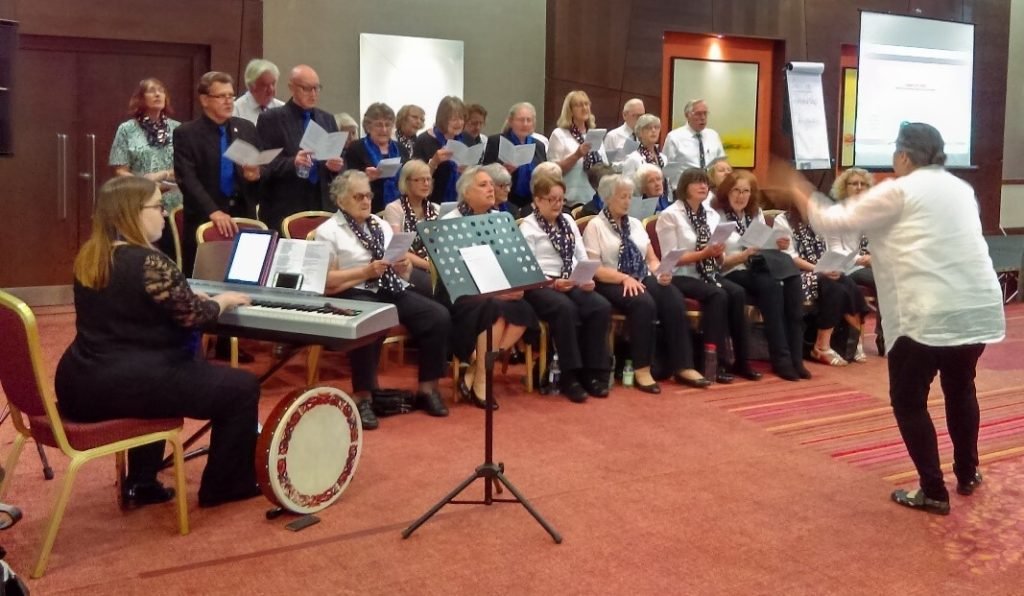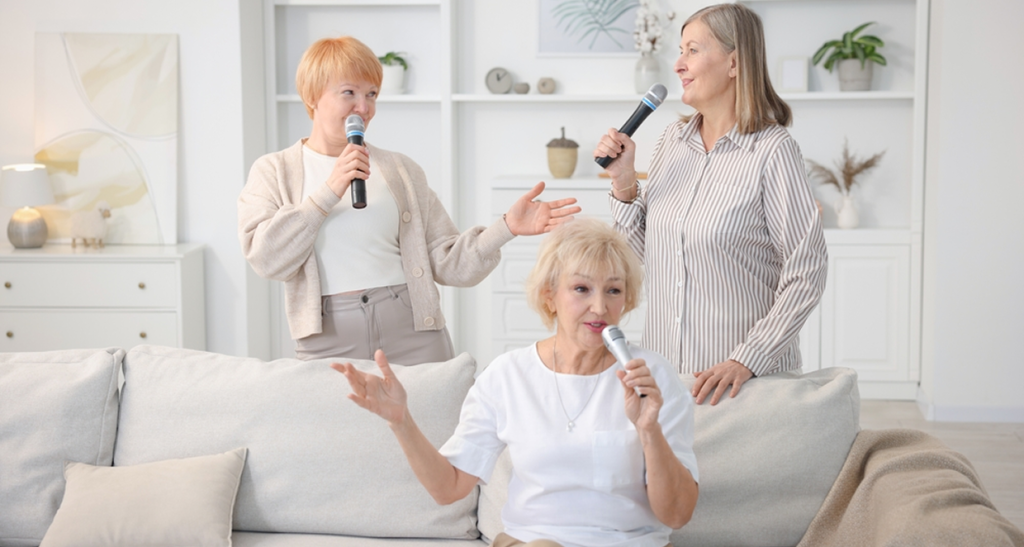Extensive research, study, an Internship in the UK and multiple pilot programs all contributed to creating StarSong’s current courses. The research provided here on our site, as well as 100’s of other references, have informed each step of program development.




2. “Community singing groups for people with chronic obstructive pulmonary disease: participant perspectives” A. Skingley., S. Clift, S. Hurley, S. Price, L. Stephens, January 2018 Vol 138 No 1 l Perspectives in Public Health – ISSN 1757-9139 DOI: 10.1177/1757913917740930
“When asked whether singing had made a difference to their breathing, 27 of the 37 responding replied affirmatively, including all six of the participants not diagnosed with COPD.”
3. “New Life into Care Pathways for Individuals with Lung Health Challenges,” Rebecca Barnstaple, PhD | University of Guelph, Arla Good, PhD • Frank A. Russo, PhD | Toronto Metropolitan University, Jane Gosine, PhD | Memorial University of Newfoundland
“Research has demonstrated group singing’s numerous psychosocial benefits and positive impacts on physical health, especially on lung function and vocal quality for those with breathing disorders. Held weekly for 12 weeks, 60-minute sessions. RESULTS: Participants reported decreases in levels of shortness of breath following singing.”
4. “Singing for Adults with Chronic Obstructive Pulmonary Disease (COPD),” McNamara RJ, Epsley C, Coren E, McKeough ZJ. Singing for adults with chronic obstructive pulmonary disease (COPD). Cochrane Database Syst Rev., Published online December 2017(12): CD012296. doi:10.1002/14651858.CD012296.pub2.
“For those who suffer from lung dysfunctions such as asthma, COPD, or chronic lung disability, research on the effectiveness of singing specifically for breathing improvement applicable to these conditions is ongoing.”
“Singing for Lung Health (SLH – based in the UK) is a program that uses singing to help people with chronic respiratory conditions improve their breathing and quality of life. SLH programs teach breathing control and posture techniques and combine them with group singing. These programs can help people feel less breathless and use their blue inhalers less often.”
“For patients at the Pulmonary Rehabilitation Clinic at Toronto Western Hospital (TWH), singing has been life-changing. The singing, in combination with the breathing exercises we do have helped to open my throat and airways,” says Helen. Studies show numerous benefits of singing for patients with various lung diseases. One of them is an increase in blood oxygen level saturation.”
7. Singwell
“Breathlessness, respiratory infections and fatigue affect pulmonary function and in turn, daily living activities. Beneficial effects of lung capacity in terms of voice (A) and exhalation duration (S and counting numbers). A choral singing intervention could then be an alternative or a complement to pulmonary rehabilitation or could be a way of maintaining quality of life.”

“Singing in a chorus seems to have a significant impact on mental health. As with adult singers of all ages, older singers report that being part of a chorus helps them feel less lonely. Older choristers are significantly less likely than the general population to say they “often feel left out” or isolated from others.”
3. “The Contribution of Community Singing Groups to the Well-Being of Older People: Participant Perspectives from the United Kingdom,” Ann Skingley, Anne Martin, and Stephen Clift, Journal of Applied Gerontology 35, no. 12 (December 2016): 1313.
“The study determined that when some seniors were feeling ‘too bad’ to undertake and activity, singing together in a group offered a pronounced motivative force to encourage sharing in the community. The accompanying benefits of participating in group musicking served as a motivation to participate which in turn increased physical activity, range of motion, and muscle retention as well as the ability to cope with general aches and pains.”
4. New Life into Care Pathways for Individuals with Lung Health Challenges, Rebecca Barnstaple, PhD | University of Guelph, Arla Good, PhD • Frank A. Russo, PhD | Toronto Metropolitan University, Jane Gosine, PhD | Memorial University of Newfoundland
“Community singing groups are an example of social prescribing that addresses social determinants of health and loneliness through non-clinical services. Research has demonstrated group singing’s numerous psychosocial benefits… Before and after the 12-week program, psychosocial wellbeing was assessed through a series of questionnaires, including scales for loneliness, social connectedness, quality of life, and severity of respiratory disease. We also tested participants before and after 60 minutes of singing to gauge mood, social bonding, and states of anxiety.
Additionally, we measured biosocial indicators including heart rate variability and levels of salivary cortisol and/or oxytocin. Preliminary results show that before and after 60 minutes of singing, participants reported: Increases in feelings of trust, liking, connection, and similarity with others in the group. Decreases in levels of distress and anxiety. In qualitative interviews, participants expressed that the singing group had a significant impact on their physical, emotional and social wellbeing.”
5. Virtually Together: Do You Hear What I Hear? A Singing Collective Unites
“Results show that online group singing in either format (high-latency audio virtual singing group to one in which a low latency (minimal lag) platform) leads to improvements in mood, decreased pain, decreased salivary cortisol, and increased feelings of connection with the group and the world as a whole.’
6. “Why singing feels good: the science behind the song”
“When we sing with others, our oxytocin levels tend to rise, which helps strengthen feelings of connection and empathy among group members. This is one reason why singing in a choir or group can foster a sense of community and reduce feelings of loneliness.”
“Community singing groups are an example of social prescribing that addresses social determinants of health and loneliness through non-clinical services. Research has demonstrated group singing’s numerous psychosocial benefits… Before and after the 12-week program, psychosocial wellbeing was assessed through a series of questionnaires, including scales for loneliness, social connectedness, quality of life, and severity of respiratory disease. We also tested participants before and after 60 minutes of singing to gauge mood, social bonding, and states of anxiety.
Additionally, we measured biosocial indicators including heart rate variability and levels of salivary cortisol and/or oxytocin. Preliminary results show that before and after 60 minutes of singing, participants reported: Increases in feelings of trust, liking, connection, and similarity with others in the group. Decreases in levels of distress and anxiety. In qualitative interviews, participants expressed that the singing group had a significant impact on their physical, emotional and social wellbeing.”

Changes to the bones and muscles of the chest and spine:
Bones become thinner and change shape. This can change the shape of your ribcage. As a result, your ribcage may not expand and contract as well during breathing. The muscle that supports your breathing, the diaphragm, becomes weakened. This weakness may prevent you from breathing enough air in or out. These changes in your bones and muscles may lower the oxygen level in your body. Also, less carbon dioxide may be removed from your body. Symptoms such as tiredness and shortness of breath can result.
Changes to lung tissue:
Muscles and other tissues that are near your airways may lose their ability to keep the airways completely open. This causes the airways to close easily. Aging also causes the air sacs to lose their shape and become baggy. These changes in lung tissue can allow air to get trapped in your lungs. Too little oxygen may enter your blood vessels and less carbon dioxide may be removed. This makes it hard to breathe.
Changes to the nervous system:
The part of the brain that controls breathing may lose some of its function, weakening the automatic breathing functions. When this happens, your lungs are not able to get enough oxygen. Not enough carbon dioxide may leave the lungs. Breathing may get more difficult.
Nerves in your airways that trigger coughing become less sensitive. Large amounts of particles like smoke or germs may collect in the lungs and may be hard to cough up.
Changes to the immune system:
Your immune system can get weaker. This means your body is less able to fight lung infections and other diseases. Your lungs are also less able to recover after exposure to smoke or other harmful particles.
COMMON PROBLEMS
As a result of these changes, older people are at increased risk for:
· Lung infections, such as pneumonia and bronchitis
· Shortness of breath
· Low oxygen level
· Abnormal breathing patterns, resulting in problems such as sleep apnea (episodes of stopped breathing during sleep)
2. “Caregiver Guide: Breathing Problems”
For Senior Adults, age-related changes in lung function can cause breathing problems and chronic respiratory issues or medical conditions.
There are several natural body changes that happen as you get older that may cause age-related breathing struggles and a decline in lung capacity. Muscles that assist with breathing such as the diaphragm can get weaker. Lung tissue that helps keep your airways open can lose elasticity, which means your airways can get a little smaller. Your rib cage bones can change and get smaller, which leaves less room for your lungs to expand.

3. “Effects of Singing Classes on Pulmonary Function and Quality of Life of COPD Patients,” Amanda Gimenes Bonilha et al., International Journal of Chronic Obstructive Pulmonary Disease 4 (April 2009): 2.
“The regular practice of singing by patients with dyspnea might also lead to “desensitization” of breathlessness due to the development of better breathing coordination, and reduce the anxiety and fear associated with unpleasant respiratory sensations.”
4. “New Life into Care Pathways for Individuals with Lung Health Challenges,” Rebecca Barnstaple, PhD | University of Guelph, Arla Good, PhD • Frank A. Russo, PhD | Toronto Metropolitan University, Jane Gosine, PhD | Memorial University of Newfoundland
“Research has demonstrated group singing’s numerous psychosocial benefits and positive impacts on physical health, especially on lung function and vocal quality for those with breathing disorders. Held weekly for 12 weeks, 60-minute sessions. RESULTS: Participants reported decreases in levels of shortness of breath following singing.”
5. “Singing for Adults with Chronic Obstructive Pulmonary Disease (COPD),” McNamara RJ, Epsley C, Coren E, McKeough ZJ. Singing for adults with chronic obstructive pulmonary disease (COPD). Cochrane Database Syst Rev., Published online December 2017(12): CD012296. doi:10.1002/14651858.CD012296.pub2.
“For those who suffer from lung dysfunctions such as asthma, COPD, or chronic lung disability, research on the effectiveness of singing specifically for breathing improvement applicable to these conditions is ongoing.”
“Singing for Lung Health (SLH – based in the UK) is a program that uses singing to help people with chronic respiratory conditions improve their breathing and quality of life. SLH programs teach breathing control and posture techniques and combine them with group singing. These programs can help people feel less breathless and use their blue inhalers less often.”
“For patients at the Pulmonary Rehabilitation Clinic at Toronto Western Hospital (TWH), singing has been life-changing. The singing, in combination with the breathing exercises we do have helped to open my throat and airways,” says Helen. Studies show numerous benefits of singing for patients with various lung diseases. One of them is an increase in blood oxygen level saturation.”
8. “Singing for Children: The physical, psychological, social, musical and educational benefits of singing” Professor Graham Welch, Institute of Education, University of London. February 2012
“Singing is aerobic… improves the efficiency of the body’s cardiovascular system, with related benefits to overall health. Singing involves dynamic thoracic activity, with benefits to the underlying structure and function of the breathing mechanism. Major muscle groups are exercised in the upper body. Furthermore, aerobic activity is linked to longevity, stress reduction and general health maintenance across the lifespan.”
A. “Can singing have a beneficial effect on lung function and breathing for people with respiratory illness?” S. Clift and R. Gilbert, (2017). In G. Welch, D. M. Howard, and J. Nix (eds) The Oxford Handbook of Singing, Oxford University Press, 889.
“The deep breathing needed (utilized) by singers has recently been shown to aid those with lung illness and could benefit many with reduced lung function who would like to improve their breathing.”
B. “Community singing groups for people with chronic obstructive pulmonary disease: participant perspectives” A. Skingley., S. Clift, S. Hurley, S. Price, L. Stephens, January 2018 Vol 138 No 1 l Perspectives in Public Health – ISSN 1757-9139 DOI: 10.1177/1757913917740930
“When asked whether singing had made a difference to their breathing, 27 of the 37 responding replied affirmatively, including all six of the participants not diagnosed with COPD.”
C. “Effects of Singing Classes on Pulmonary Function and Quality of Life of COPD Patients,” Amanda Gimenes Bonilha et al., International Journal of Chronic Obstructive Pulmonary Disease 4 (April 2009): 2.
“The regular practice of singing by patients with dyspnea might also lead to “desensitization” of breathlessness due to the development of better breathing coordination, and reduce the anxiety and fear associated with unpleasant respiratory sensations.”
D. “New Life into Care Pathways for Individuals with Lung Health Challenges,” Rebecca Barnstaple, PhD | University of Guelph, Arla Good, PhD • Frank A. Russo, PhD | Toronto Metropolitan University, Jane Gosine, PhD | Memorial University of Newfoundland
“Research has demonstrated group singing’s numerous psychosocial benefits and positive impacts on physical health, especially on lung function and vocal quality for those with breathing disorders. Held weekly for 12 weeks, 60-minute sessions. RESULTS: Participants reported decreases in levels of shortness of breath following singing.”
E. “Singing for Adults with Chronic Obstructive Pulmonary Disease (COPD),” McNamara RJ, Epsley C, Coren E, McKeough ZJ. Singing for adults with chronic obstructive pulmonary disease (COPD). Cochrane Database Syst Rev., Published online December 2017(12): CD012296. doi:10.1002/14651858.CD012296.pub2.
“For those who suffer from lung dysfunctions such as asthma, COPD, or chronic lung disability, research on the effectiveness of singing specifically for breathing improvement applicable to these conditions is ongoing.”
F. Singing for Lung Health – UK program – blf.org.uk/singing
https://www.asthmaandlung.org.uk/sites/default/files/IS37_Singing%20for%20lung%20health_2017_v2.2.pdf
“Singing for Lung Health (SLH – based in the UK) is a program that uses singing to help people with chronic respiratory conditions improve their breathing and quality of life. SLH programs teach breathing control and posture techniques and combine them with group singing. These programs can help people feel less breathless and use their blue inhalers less often.”
G. Singing to Breathe – Uhnfoundation.ca – UHN is Canada’s #1 hospital https://uhnfoundation.ca/stories/legacy-gift-provides-healing-power-of-music-for-lung-patients/
“For patients at the Pulmonary Rehabilitation Clinic at Toronto Western Hospital (TWH), singing has been life-changing. The singing, in combination with the breathing exercises we do have helped to open my throat and airways,” says Helen. Studies show numerous benefits of singing for patients with various lung diseases. One of them is an increase in blood oxygen level saturation.”
H. “Singing for Children: The physical, psychological, social, musical and educational benefits of singing” Professor Graham Welch, Institute of Education, University of London. February 2012 https://www.singupfoundation.org/_files/ugd/d3e4fd_d72be6b4c38d4ace816abe7fb78668bc.pdf
“Singing is aerobic… improves the efficiency of the body’s cardiovascular system, with related benefits to overall health. Singing involves dynamic thoracic activity, with benefits to the underlying structure and function of the breathing mechanism. Major muscle groups are exercised in the upper body. Furthermore, aerobic activity is linked to longevity, stress reduction and general health maintenance across the lifespan.”



“Findings comparing older choristers (65+) to older Americans in general suggest that choral singing may be an important way to help older Americans remain active and stay healthier longer.”
3. “Chapter 25: Singing and Quality of Life,” in The Oxford Handbook of Community Music” Patricia Lee, Donald Stewart, and Stephen Clift, ed. Brydie-Leigh Bartleet and Lee Higgins (New York: Oxford University Press, 2018), accessed March 1, 2019,
“Results after participatory singing show the immune response has, “a significant increase in secretory immunoglobulin A (1gA) associated with an enhanced immune function specifically in respiratory function.” Accordingly, this quantitative study revealed, “the amount of secretory immunoglobulin A (S-IgA) was significantly decreased (p < 0.01, main effect) before singing (28.8 ± 16.3 ng/ml) compared with the amount after singing (17.7 ± 9.3 ng/ml).”
4. “The Contribution of Community Singing Groups to the Well-Being of Older People: Participant Perspectives from the United Kingdom,” Ann Skingley, Anne Martin, and Stephen Clift, Journal of Applied Gerontology 35, no. 12 (December 2016): 1313.
“The accompanying benefits of participating in group musicking served as a motivation to participate which in turn increased physical activity, range of motion, and muscle retention as well as the ability to cope with general aches and pains.”
5. “Hospital-based Arts on Prescription Programme supports patients to better self-manage chronic conditions” Jane Willis,” WILLIS NEWSON, September 5, 2019, accessed October 27, 2019,
“Patients shared responses to music participation including: ‘Even though we’re all down with pain, we’ve all created a happy moment,’ and ‘Really rewarding to just be me and not my condition. I’ve felt like me again.’”
6. “New Theories and Research Findings on the Positive Influence of Music and Art on Health with Ageing,” Gene Cohen, Arts and Health 1, no. 1 (2009): 49–50,
“…music boosts the immune-enhancing function results in more T cells (lymphocytes) fighting off infections and more NK (natural killer) cells”
7. “Singing for Children: The physical, psychological, social, musical and educational benefits of singing” Professor Graham Welch, Institute of Education, University of London. February 2012
“Singing is aerobic in that it is a form of exercise that improves the efficiency of the body’s cardiovascular system, with related benefits to overall health. Aerobic activity increases the oxygenation of the blood, which also improves overall alertness. (A study in October 2007, for example, suggested that breathing pure oxygen was more beneficial than caffeine for increasing driver alertness.) Even when seated, singing involves dynamic thoracic activity, with benefits to the underlying structure and function of the breathing mechanism. Major muscle groups are exercised in the upper body. Furthermore, aerobic activity is linked to longevity, stress reduction and general health maintenance across the lifespan. Improving airflow in the upper respiratory tract is likely to lessen opportunities for bacteria to flourish by keeping the airways open (e.g., to counter the symptoms of colds and flu). Overall, there are whole body physical benefits from singing.”
8. “A systematic review on the effects of group singing on persistent pain in people with long-term health conditions” Irons JY, Sheffield D, Ballington F, Stewart DE. Eur J Pain. 2020 Jan;24(1):71-90. doi: 10.1002/ejp.1485. Epub 2019 Oct 15. PMID: 31549451; PMCID: PMC6972717.
“Group singing appears to have the potential to reduce pain intensity, pain interference and depression.”
9. “Virtually Together: Do You Hear What I Hear? A Singing Collective Unites”
“Results show that online group singing in either format (high-latency audio virtual singing group to one in which a low latency (minimal lag) platform) leads to improvements in mood,decreased pain, decreased salivary cortisol, and increased feelings of connection with the group and the world as a whole.”

“Current research suggests that participation in music-making activities also elicits physicochemical responses such as an increase of dopamine and neurotransmitter levels. Both singing in a group and the anticipation of the event once an established exercise, can lead to, “feelings of euphoria, and craving, and may explain why music is of such high value across all human societies.”
2. “Arts in Medicine Literature Review” Gay Hanna, – Grantmakers in the Arts Funder Forum (February 2017): 9, accessed May 23, 2018,
“The physical action of singing and its related breathing mechanisms rely upon moving air in and out of the body, which can then improve oxygenation and positively affect the cognitive health of Senior Adult’s by slowing the mental decline often associated with aging, thereby leading to a potentially increased rate of mental information processing.”
3. “Beneficial effects of choir singing on cognition and well-being of older adults: Evidence from a cross-sectional study.” Pentikäinen, E., Pitkäniemi, A., Siponkoski, S.-T., Jansson, M., Louhivuori, J., Johnson, J. K., Paajanen, T., & Särkämö, T. (2021). PloS One, 16(2), e0245666–e0245666.
“In the brain, music engages multiple cognitive, motor, emotional, and social processes mediated by a wide-scale, largely bilateral network of cortical and subcortical brain region.s In the neuropsychological testing, choir singers performed better than controls on the verbal flexibility domain of executive function…”
4. “The Benefits of Singing,” Graham Welch, The Physical Benefits of Singing Relate to Respiratory and Cardiac Function, Singing Up, 2019, accessed October 15, 2019,
“…opportunities to sing together also builds self-confidence and bolsters self-esteem”
5. Chorus America. (2009). The chorus impact study
“Our research suggests that choral singing plays an important role in singers’ lives, contributing to positive personal qualities like optimism, resilience, and mindfulness, and to their feelings of connection to others.”
6. “The Contribution of Community Singing Groups to the Well-Being of Older People: Participant Perspectives from the United Kingdom,” Ann Skingley, Anne Martin, and Stephen Clift, Journal of Applied Gerontology 35, no. 12 (December 2016): 1313.
“Meeting socially with others of like-mind, making new friends, and receiving peer support in the local community counteract loneliness felt from isolation.”
“The study determined that when some seniors were feeling ‘too bad’ to undertake and activity, singing together in a group offered a pronounced motivative force to encourage sharing in the community. The evidence from individual testimonies of specific benefits further highlighted a more nuanced account of individual motivations, satisfaction, preferences, and changing experiences over time, as well as explanations of the mechanisms through which singing promotes well-being and health.”
7. “Effects of Singing Classes on Pulmonary Function and Quality of Life of COPD Patients,” Amanda Gimenes Bonilha et al., International Journal of Chronic Obstructive Pulmonary Disease 4 (April 2009): 2.
“Additional therapeutic options such as singing together could act on “alternative biochemical targets,” among them dopamine. Significant improvements in perceived quality of life were noted as a result of singing group interaction.”
8. “Impact of Arts Participation on Health Outcomes for Older Adults” Melissa Castora-Binkley, M., L. Noelker, T. Prohaska, et al., Journal of Aging, Humanities, and the Arts 4, no. 4 (2010): 354.
“Chapter Ten of the book outlines the benefits of arts participation for senior adults and advises, “for senior citizens’ service providers, regular musical participation opportunities in various musical styles should be available for the long term, as well as musical activities that help to connect with senior citizens’ inner selves, others, and their past, present, and future lives.”
9. “Possible Benefits of Singing to the Mental and Physical Condition of the Elderly” Katsuhisa Sakano et al., BioPsychoSocial Medicine 8, no. 1 (2014): 8.
“In addition to the release of dopamine creating a pleasant feeling, researchers have identified the potential for a reduction of levels of cortisol, a stress indicator, after engaging in singing activities. Surprisingly, this lowered cortisol level occurred even in those people who participated in the study but do not claim to even enjoy singing.”
10. “A systematic review on the effects of group singing on persistent pain in people with long-term health conditions” Irons JY, Sheffield D, Ballington F, Stewart DE. Eur J Pain. 2020 Jan;24(1):71-90. doi: 10.1002/ejp.1485. Epub 2019 Oct 15. PMID: 31549451; PMCID: PMC6972717.
“Group singing appears to have the potential to reduce pain intensity, pain interference and depression.”
11. What is Senior Life Enrichment?
“It is best to provide ample opportunity for meeting new people and building new connections. opportunities for friendship. They (residents) need to know that they are not alone. Opportunities to sing together help them feel there is no reason to isolate themselves and will feel motivated to be active.”
12. Virtually Together: Do You Hear What I Hear? A Singing Collective Unites
Community singing groups are an example of social prescribing…. Preliminary results show that before and after 60 minutes of singing, participants reported: Increases in feelings of trust, liking, connection, and similarity with others in the group and a decrease in levels of distress and anxiety. Additional results show that online group singing in either format (high-latency audio virtual singing group to one in which a low latency (minimal lag) platform) leads to improvements in mood, decreased pain, decreased salivary cortisol, and increased feelings of connection with the group and the world as a whole.